

Fenian Cycle. Plot summary[edit] Cormac mac Art, the High King of Ireland formed the Fianna, a coalition of clans, for the protection of the kingdom.
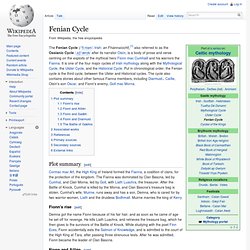
The Fianna was dominated by Clan Bascna, led by Cumhal, and Clan Morna, led by Goll, with Liath Luachra, the treasurer. After the Battle of Knock, Cumhal is killed by the Morna, and Clan Bascna's treasure bag is stolen. Cumhal's wife, Muirne, runs away and has a son, Demna, who is cared for by two warrior women, Liath and the druidess Bodhmall. Muirne marries the king of Kerry. Fionn's rise[edit] Demna got the name Fionn because of his fair hair, and as soon as he came of age he set off for revenge. Fionn and Aillén[edit] Every Samhain, the phantom Aillén mac Midgna, or Aillén the Burner, would terrorise Tara, playing music on his harp that left every warrior helpless.
Fionn and Sadbh[edit] Fionn and Diarmuid[edit] The Battle of Gabhra[edit] Associated works[edit] Seventh century: Late eighth or early ninth century: Ninth century: Tenth century: Ulster Cycle. The Ulster Cycle (Irish: an Rúraíocht),[1] formerly known as the Red Branch Cycle, one of the four great cycles of Irish mythology, is a body of medieval Irish heroic legends and sagas of the traditional heroes of the Ulaid in what is now eastern Ulster and northern Leinster, particularly counties Armagh, Down and Louth, and taking place around or before the 1st century AD.
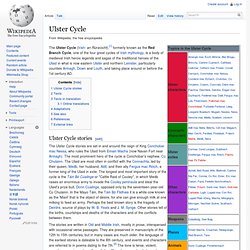
Ulster Cycle stories[edit] The Ulster Cycle stories are set in and around the reign of King Conchobar mac Nessa, who rules the Ulaid from Emain Macha (now Navan Fort near Armagh). The most prominent hero of the cycle is Conchobar's nephew, Cú Chulainn. The Ulaid are most often in conflict with the Connachta, led by their queen, Medb, her husband, Ailill, and their ally Fergus mac Róich, a former king of the Ulaid in exile. The stories are written in Old and Middle Irish, mostly in prose, interspersed with occasional verse passages.
Texts[edit] Earliest strata Compert Birth Wooings and elopements Feasts Cath 'Battle' Mythological Cycle. The Mythological Cycle [1][2] is a somewhat outdated coined term[3] still used to refer collectively to an ancient literary tradition that concerns the godlike peoples who allegedly arrived in five migratory invasions into Ireland and principally recounts the doings of the Tuatha Dé Danann.[4] It comprises one of the four major cycles of early Irish literary tradition, the others being the Ulster cycle, the Fenian Cycle and the Cycles of the Kings.[5] The topic is also surveyed under Irish mythology, Mythological cycle.
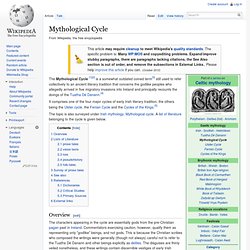
A list of literature belonging to the cycle is given below. Overview[edit] The characters appearing in the cycle are essentially gods from the pre-Christian pagan past in Ireland. Examples of works from the cycle include numerous prose tales, verse texts, as well as pseudo-historical chronicles (primarily the Lebor Gabála Érenn (LGE), commonly called The Book of Invasions) found in medieval vellum manuscripts or later copies. Tuatha Dé Danann. Much of Irish mythology was recorded by Christian monks, who modified it to an extent.
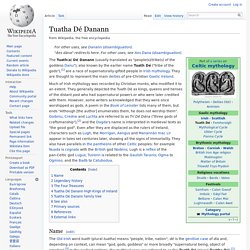
They generally depicted the Tuath Dé as kings, queens and heroes of the distant past who had supernatural powers or who were later credited with them. However, some writers acknowledged that they were once worshipped as gods. A poem in the Book of Leinster lists many of them, but ends "Although [the author] enumerates them, he does not worship them". Goibniu, Credne and Luchta are referred to as Trí Dé Dána ("three gods of craftsmanship"),[2] and the Dagda's name is interpreted in medieval texts as "the good god". Irish mythology. Bunworth Banshee The mythology of pre-Christian Ireland did not entirely survive the conversion to Christianity.
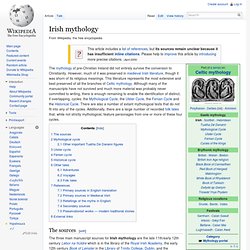
However, much of it was preserved in medieval Irish literature, though it was shorn of its religious meanings. This literature represents the most extensive and best preserved of all the branches of Celtic mythology.